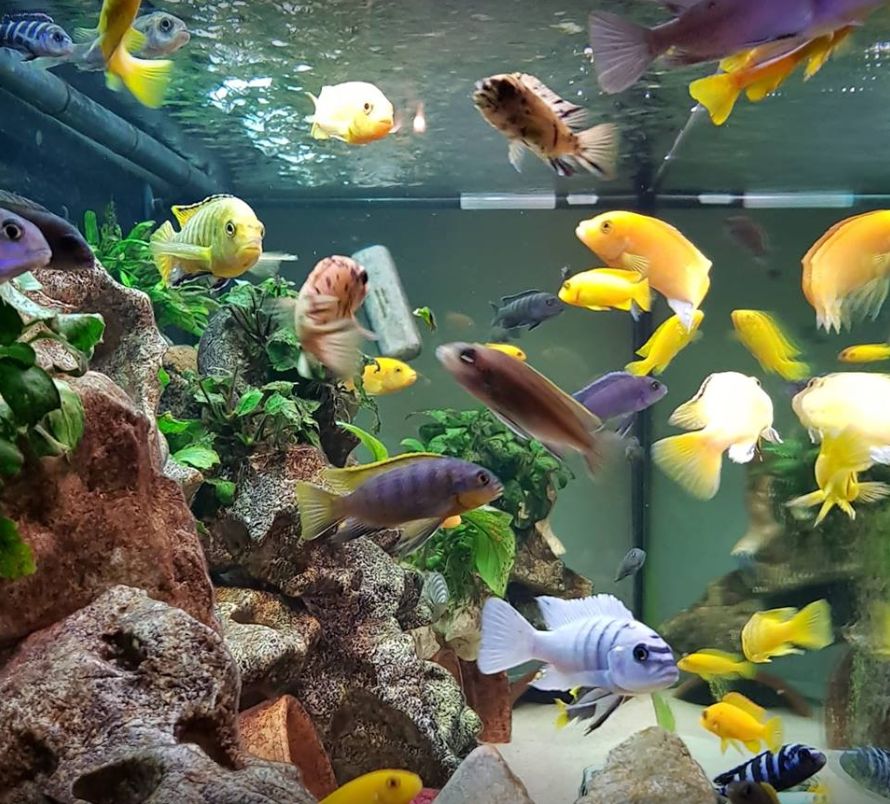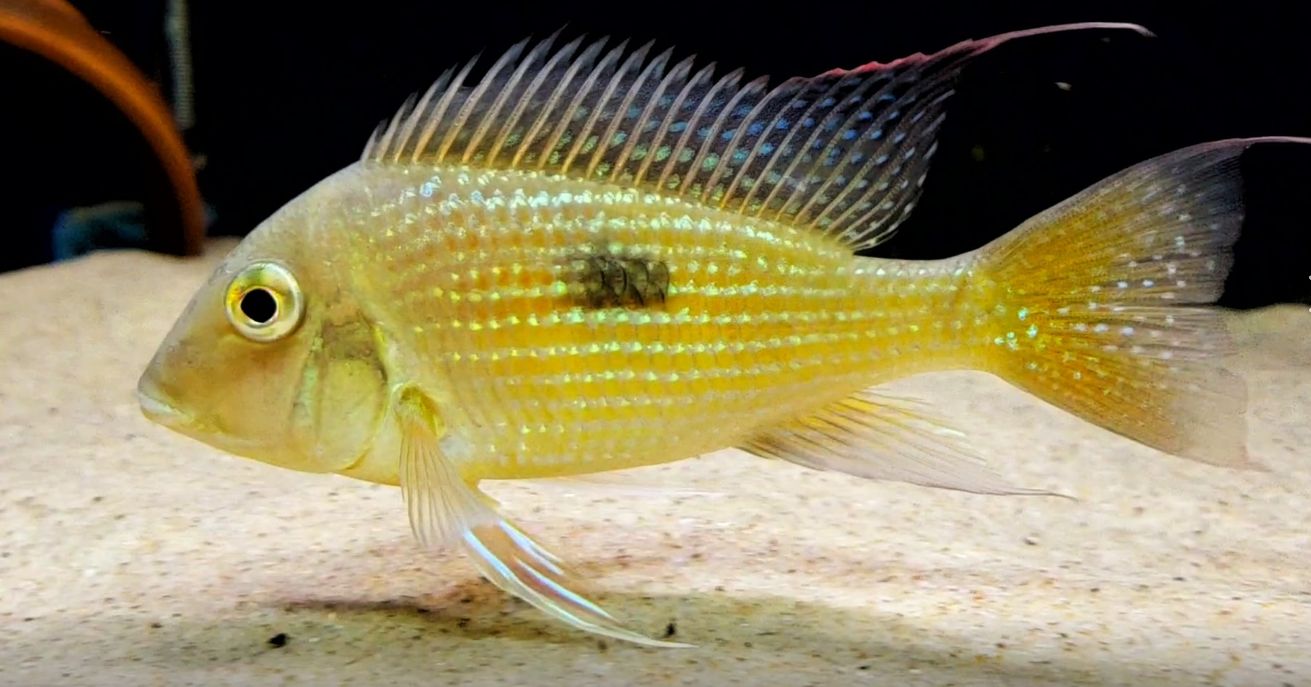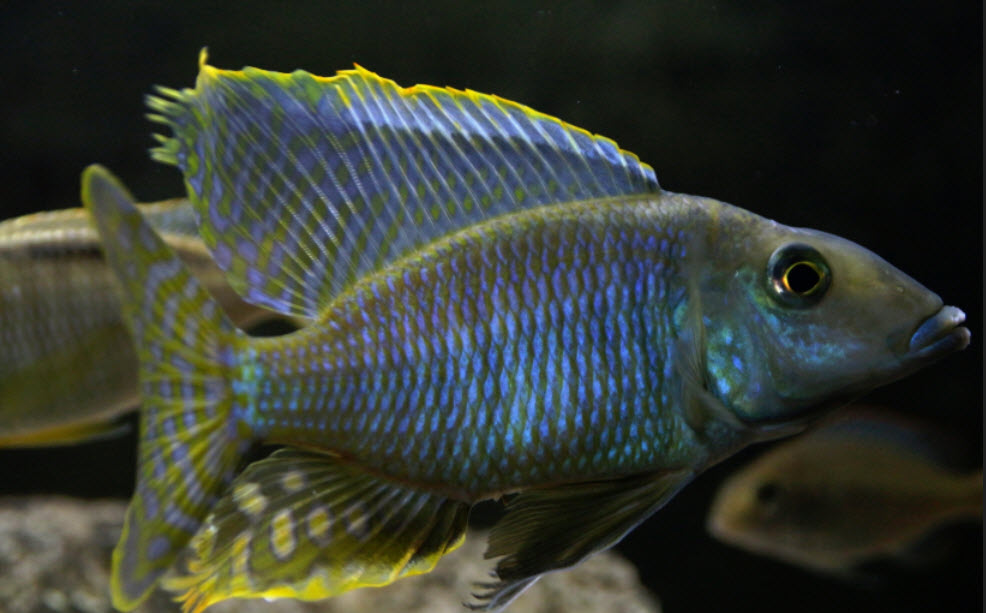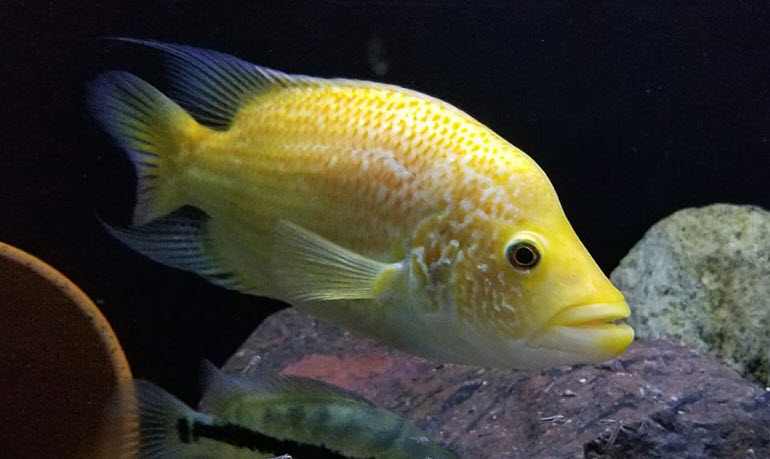
Many times, fish keepers get a pathogen in their aquarium which defies diagnosis. They are doing everything right and fish are still dying. Their water is well filtered and crystal clear. There are no bacteria in the water column. Their aeration is great. And yet their fish are dying with no apparent symptoms.
This is best treated with what is known as a “shotgun” approach. There are four treatable pathogens which are the “most likely suspects” in “slow fish deaths” in an aquarium. The treatable pathogens are flatworms (flukes and tapeworms), nematodes (capillaria and camallanus), “internal parasites” (hexamita) and bacteria (most commonly columnaris and aeromonas).
It should be noted that the most common cause of “slow fish deaths”, namely “fish TB” (environmental mycobacteriosis) has no effective medication and is best treated by improving the biofiltration and adding UV sterilization.

Special Medicated Fish Food
For the “shotgun” approach make two special foods. Buy over the internet:
- Fenbendazole (for nematode worms)
- PraziPro (praziquantel for flukes and tapeworms)
- Maracyn 2 (antibiotic for bacteria)
- SeaChem MetroPlex (metronidazole for “internal parasites”, hexamita)
Then make two different medicated foods via the same method. Mix one food with the Bendazole and the PraziPro. Mix the other food with the Maracyn 2 and the Metroplex.
Heat 1/4 cup water (two ounces or 58 milliliters, not a lot) in the microwave. Then blend seven grams of plain animal derived gelatin (Knox gelatin, one packet) into the hot solution with vigorous stirring. Take two tablespoons of dry commercial fish food (pellets or flake) and mix it with just a little of the hot water/ gelatin mixture. Add hot water/gelatin until you get a paste like consistency. If it gets too watery just add more food. To get gel food to float simply mix in a little whipped cream at this point.

Then add just a “smidgen” (roughly 1/16 teaspoon, a 1% to 2% addition, the size of a grain of barley) of crushed medication to the mud. If you are using more than one medication mix the powdered medications together, then use just a “smidgen” of the mixture. If you are using a packet of medication, take just a “smidgen” of the packet contents. Mix and mash the whole mass thoroughly. Spread it out into a pancake about 1/8th inch (3 mm) thick on a plastic film or a plate. Then put in the refrigerator. If you plan on keeping it for more than two weeks put it in a small plastic bag and freeze.
Feed the fenbendazole and the praziquantel once a week for three months. Feed the antibiotic and metronidazole every day as a steady diet for ten days. Note while the fish won’t eat it like they normally do, they typically will eat some if you just leave it in the tank.
All four medications treat only relatively narrow classes of organisms. This is opposed to things such as disinfectants which kill any living cell they can penetrate. This make these medications very safe. All four are also approved by the FDA for use internally in humans. While not a 100% guarantee, this would indicate they are probably safe in fish.

Other Medications Which Will Work
Each of the four drugs above has some alternatives and options:
- Fenbendazole is available as Safeguard for dogs or several livestock dewormers. An alternative medication is Levamisole which is available on Amazon, subaquaria .com and Valleyvet .com. Levamisole can also be purchased as Agrilabs Prohibit Soluble Drench Powder and Durvet Levamed Soluble Drench Powder Dewormer. Other medications supposedly effective against roundworms are Pyrantel Pamoate, Flubendazole (Kusuri Wormer Plus) and Piperazine.
- Praziquantel can be purchased as PraziPro, Aquascape praziquantel, Prazi-Power, Prazi-Cure and Aqua-Prazi.
- Broad spectrum antibiotics available in the US include Midland Vet Service Aqua-Mox, SeaChem KanaPlex, VetDepot Amoxicillin, Fishbiotic Ampicillin, Mardel Maracyn 2.
- Metronidazole, alias metro’ is available in SeaChem MetroPlex and can be simply mixed into the food. Or it can come in premixed food medication such as Hikari Metro Plus food or New Life Spectrum Hex-Shield food.
In API General Cure, metronidazole is combined with praziquantel. Ron’s cichlid’s has an excellent medicated food which combines some of the above medications. Per Ron, Ron’s food has metronidazole, praziquantel, levamisole, sulfathiazole, neomycin sulfate, kanamycin and nitrofurantoin. It does not appear to have fenbendazole. This is a reasonably priced food that covers all most all of the available bases.

.
Return to Treatment Menu
.
Aquarium Science Website
The chapters shown below or on the right side in maroon lead to close to 400 articles on all aspects of keeping a freshwater aquarium. These articles have NO links to profit making sites and are thus unbiased in their recommendations, unlike all the for-profit sites you will find with Google. Bookmark and browse!
.

Dave says
In reply to Rebel …… I would use three ingredients in the bath …. Metroplex, Maracyn and Prazipro. And Kanaplex is worthless when added to the aquarium water.
Rebel Fornea says
Hi, was hoping for some advice here. I have a marbled hatchetfish (small blackwater surface-dwelling fish) that isn’t eating, and is moving somewhat lethargically. I am not sure what is wrong with the fish. I was considering using a shotgun approach but wanted to know the best combination of medications based on what I have available, since I don’t have all the meds listed in this article. What I was planning on doing is the shallow-bath method where the fish flops around and gasps for a few minutes and ingests some medicine. Here is what I have:
* Ich-x
* meth blue
* eSHa 2000
* kanaplex
* metroplex
* maracyn
* paracleanse
* prazi-pro
Is there a combination of these meds that would work for a “shotgun” style approach in the shallow-bath method? As I mentioned, the fish isn’t eating.
(I’ve been adding kanaplex to the water since supposedly that is one medication that can be absorbed through the aquarium, but I am not sure how true that is…)
Dave says
In reply to Anonymous ….. just a tiny amount of medication, like the size of a barley grain, crushed and mixed into two tablespoons of food.
Anonymous says
How much do the concentration of medication in say a dog dewormer matter? I found one with the following:
Praziquantel 50mg/tablet and Fenbendazole 500mg/tablet
So one tablet contains this amount each. Would these be too high if using 1/16th or is the amount to overdose quite high for these types of medicine?
Dave says
In reply to Mark B ….. Great way to feed the medicated food. And it will be fine in the refrigerator for several weeks.
Mark B says
Hi Dave,
I have mostly small (1”-2.5”) fish. When feeding medicated food to the tank, I freeze the food “puck” and use a lemon zester to grate out a meal’s worth onto a coated paper plate. I then dry the plate a few feet away from a fan in a room with low humidity. An hour later I scrape the dry granules off and feed to the fish.
My question: Would I degrade or reduce the effectiveness of any of the meds if I were to grate and dry 7-10 days worth of medicated food, then store in an airtight container in the fridge?
Thanks, Mark B
Dave says
In reply to Osman … Antibiotics are degraded by bacteria. As long as the antibiotic laced food is kept cold it should be stable.
Osman says
Thank you very much for all the information you have published. It takes time to sober up, but once we grasp it, we get rid of the information we are used to.
There is something I’m curious about. When the antibiotics we mix in the feed meet with water (I was confused because the effect of Metronidazole says 8 hours in the package insert), do they maintain their effect? Is it necessary to feed at that moment?
Kind Regards
Dave says
In reply to Jake …. Ron gave the formula to me.
Jake says
What is your source for the contents of Ron’s medicated food?
Dave says
In reply to Sarah ….. Just follow the directions for the dewormer found in this article. The white spots on the head are a problem. Is the water crystal clear?
Sarah says
Hi Dave,
Ive managed to get fenbendazol, levamisole and api general cure here in australia and im trying to work out how best to combine this food to treat my fish. I keep bolivian butterflies and one has internal worms (i can see, they are red) and two now have white spots on their head. Im trying to treat both but have been unsuccessful. Any help would be great its very difficult to get anything here in Aus and Rons food is unavailable.
Im not sure the best way to approach it medication wise. Tank is well over filtered with a large canister, ive put a UV sterilizer on the filter outflow (into the tank) about a week ago and do weekly 50% water changes and sand vaca to help get rod of the parasites. Two of the sick fish are still breeding and all fish are eating very well.
Kind regards
Sarah
Mountry says
I share this article on a forum all the time. I personally don’t use the antibiotics unless absolutely necessary but I use this method for parasites and it works great. I really appreciate all you do maintaining this website.
James k. says
Hi Dave,
Do we know if we can treat catfishes/loaches with the Minocycline and metronidazole mix you mention?
Dave says
In reply to Nikos …… Bactopur will work at the smidgen Level in food. Omnipur will be poisonous in the food and can ONLY be added to the water to treat ich.
Nikos says
Thank you very much Dave!
I have a question regarding the medicine’s dosage.
You mention “add just a “smidgen” (roughly 1/16 teaspoon, a 1% to 2% addition) of medication to the mud”,
is the 1-2% dosage safe for “all” antibiotics?
Particularly, since in EU your suggested medicines are not available,
I am going to use Sera Baktopur Direct [1] and/or Sera Omnipur A [2].
[1] Composition (per tablet tablet): Nifurpirinol 27.6 mg, binding agent ad 1.0 g.
[2] Composition (in 50ml): acriflavinium chloride 3.2 g, malachite green oxalate 79 mg, aqua purificata ad 100 ml
Nikos says
Dave, Thank you very much!
Another question I have.
You mention here (also in 12.7. Making Medicated Food) “add just a “smidgen” (roughly 1/16 teaspoon, a 1% to 2% addition) of medication”.
I am wondering if the 1-2% is safe for most antibiotic medicines.
Since in EU, most of the US medicines are not available, I want to use Sera Baktopur Direct [1] and/or Sera Omnipur A [2].
Is the 1-2% dosage safe for these cases?
[1] https://www.sera.de/us/product/marine-aquarium/sera-baktopur-direct/
Composition: Nifurpirinol 27.6 mg, binding agent ad 1.0 g.
[2] https://www.sera.de/us/product/freshwater-aquarium/sera-omnipur-a/
Composition: acriflavinium chloride 3.2 g, malachite green oxalate 79 mg, aqua purificata ad 100 ml.
Best regards.